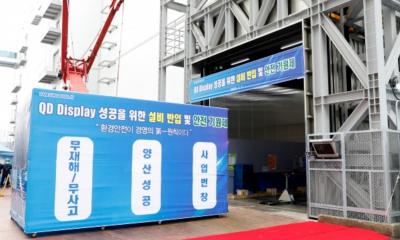Reports from Korea say that Samsung Electronics plans to reveal its first QD-OLED TV at CES 2022 (5-8, January, 2022). The company hopes the new OLED TV technology (produced by Samsung Display) will enable it to compete with LG in the premium OLED TV market.


This was already reported back in July 2021, when it was said Samsung's first TVs will be 55" and 65" in size, with 70-inch panels arriving later in 2022.
In 2019 Samsung Display formally announced its decision to invest $10.85 billion in QD-OLED TV R&D and production lines. SDC is on track to start mass production of its first QD-OLED panels soon.
Comments
If I understand the technology correctly, they will use a blue OLED back light and QDs for color conversion. I am curious to learn how they adress the issue of burn in, as compared to traditional RGB or WRGB OLEDs. I imagine this would be even more critical for a panel fully made from lower lifetime (and less efficient) blue light emitting materials.
What's held up computer sized panels that Qdot will resolve? I was wondering why we only have large and handheld and nothing inbetween.
We believe there are several reasons for that. First of all, IT displays have stronger demands on lifetime and may suffer from worse burn-in due to the UI use (monitors, laptops, etc). Second, for mobile-display production processes (used for smartphones/wearables), increasing the size is less effective. For large-size production (WOLED Processes) it is probably more lucrative to go for larger panels, and IT panels were not in high demand up until the pandemic...
I could imagine that they adress burn in kinda like this: since there are now more than only one light source, the risk of burn in will be much smaller.
And what technology is used for laptops? 13-16 inch displays seem to have become plentiful recently and they are used with the same windows UI as proper 20-32 monitors. But the latter are almost imposibly tp come by, especially at reasonable prices


Let’s hope it’s not going to be unveiled the same way they previously unveiled their OLED TVs on the same CES 2012 where LG unveiled theirs, or the way Sony unveiled their Crystal LED.
And if the new Samsung QD-OLED TVs really hit the market, their sizes will hopefully start at 42-48 inches like those by LG, and won’t be something huge and non-consumer-oriented like that Samsung currently offers with their MicroLED products.
Some rumors that Sony is going to offer their own OLED TVs based on Samsung’s QD-OLED panels, somewhat increases the probability of that the new products are now real and not pure-exhibition-oriented vapourware.
And yeah, maybe QD-OLED will finally open the way to computer OLED monitors. And by saying monitors, I mean displays with a size of 24-27″, not just a 55″ TV with a DisplayPort input.